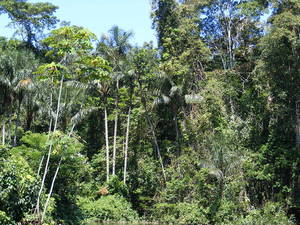Back in 2005, the Amazon, which covers nearly 7 million km squared of South America, suffered a drought which was billed as a 'once in a century' event. Droughts like this are caused by increased sea surface temperatures in the atlantic ocean.
Now a team led by Simon Lewis from the University of Leeds have analysed data from another drought, in 2010, and concluded that this was in fact even more serious, and that these successive droughts could start causing big global problems.
They found 57% of the Amazon region had low rainfall in 2010 compared to 37% in 2005, and also that the water stress on trees was more severe. They worked this out using a measure of drought severity called the maximum climatological water deficit, that correlates with how likely trees are to die from a drought, which they calculated by taking away the estimated transpiration of the trees - that's the amount of water they lose from their leaves - from the lowest amount of water input to the region. So doing this they estimated 3.2km2 of forest in 2010 would have suffered a level of drought enough to cause significant tree death compared to 2.5km2 in 2005.
So why is this important? Well the Amazon acts as a giant carbon sink - sucking CO2 out of the atmosphere and locking it away in plant matter, which has helped to act like a buffer against all the extra CO2 humans have been pumping up into the atmosphere. But if droughts like the 2005 and 2010 events keep happening, and they will if sea surface temperatures continue to rise as they have been in recent years, more trees will die. This means that not only will the trees stop taking in CO2, but they will actually start to release it as a result of being broken down by microbes. Another effect of increasing temperatures, combined with a build up of dead plant material is an increase in the likelihood of forest fires, which can release huge amounts of CO2.
Simon Lewis and his colleagues suggest that this could become a positive feedback cycle, resulting in major forest loss and the loss of an important carbon buffering system, which could have major global implications.










Comments
Add a comment